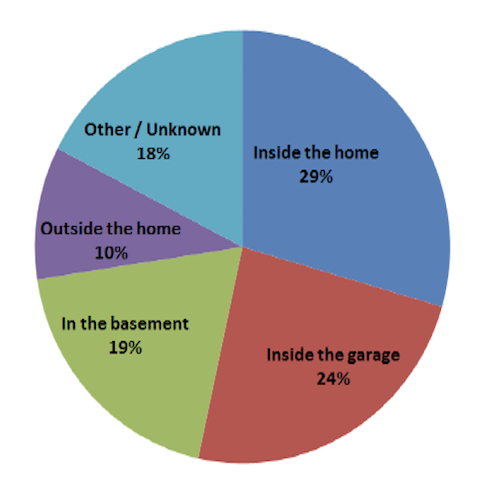Even outside, portable generator danger is beyond imagination.
Portable generator danger was greater than imagined in Olathe, Kansas where four were hospitalized Saturday June 17, 2017 with carbon monoxide poisoning. Since we started blogging on this topic, not a day goes by that someone doesn’t say to us that the solution to the portable generator mayhem is for people to simply take the generators outside. Each time we state our position that the generator manufacturers must be sued in these cases, someone blames it on the victims.
Based on photo evidence from the scene of the latest poisoning event over the weekend in suburban Kansas City, the generator that poisoned these four individuals was being run outside the dwelling. See http://www.kansascity.com/news/local/article156820669.html for the photo.

The unpredictable nature of portable generator danger is shown by this graphic where only 29% of the fatalities occur inside the home. Like the 10% shown above, the generator appears to have been outside in the Olathe, Kansas poisoning. The above graph is from the Portable Generator Manufacturers 2016 Technical Summit, a summit which has yet to find a solution.
How can a generator be so dangerous that it can poison from outside a dwelling? The answer is 85,000 ppm. That is how much carbon monoxide poison a generator has in its exhaust, when operating properly. This is nearly 20 times the amount a carbon monoxide detector can read. Not a residential carbon monoxide detector, but the professional detectors used to measure the carbon monoxide in the exhaust of furnaces and other household gas burning appliances.
It is hard to explain to people who have not had a carbon monoxide detector near a portable generator to imagine how dangerous they are. Walk within five feet of a portable generator running outside, and levels will begin to climb. I recently saw a detector go off within five seconds.
How can these generators still be so dangerous? Because generators were not considered a significant contributor to air pollution at the time the EPA mandated cleaner cars in 1970. Thus, they have had little regulation.
Why Portable Generator Danger Continues?
Does the generator industry understand how dangerous their product is? Are they fully aware of the 751 deaths and 25,000 cases of medical treatment between 2004 and 2014 related to their product? I will let the Portable Generator Manufacturer’s Association answer that question. A timeline of the industry’s presumptive knowledge of this danger is in the PGMA’s 2016 Technical Summit. My comments are in parenthesis and italicized:
- 2009 – Generator manufacturers join forces as PGMA to create and promote safety standards for portable generators and began work on safety standard. (Create and promote means lobbying.)
- 2012 – Education Awareness Subcommittee Formed (Why three years to form an education awareness subcommittee?)
- 2012 – Support adoption of CO monitor as part of building code
- 2013 – Support NARUC CA-1 Resolution Recognizing the Importance of Educating Consumers on Portable Generator Carbon Monoxide Safety (All the focus is on the consumer not the industry.)
- 2013 – Communications Subcommittee Formed
- 2013 – Safety First Program Begins
- 2013 – PGMA contracts consultant to study deaths related to portable generators to identify trends that could be used to formulate potential solution options. (CPSC has been providing this information for a decade at this point.)
- 2014 – PGMA Public Relations Campaign Begins (PR not solutions.)
- 2014 – PGMA actively participates and works collaboratively in the UL CO Task Group
- June 2015 – PGMA G300 Safety and Performance of Portable Generators Standard obtained recognition as an ANSI standard.(Does this standard lower emissions? Not.)
- October 2015 – PGMA Launches “Take it OutsideTM” Safety Awareness Campaign
The PGMA addressed everything at its technical summit that they could think of to point the finger at the consumer for misusing the generator. They talk about how consumer’s need to know how dangerous their machines are, not how to make them less dangerous. Unless you have actually tested one of these machines, you can’t fathom how dangerous they are. Even professional engineers who work in this industry don’t perceive how dangerous these machines are until they strap on a carbon monoxide detector and go near a portable generator’s exhaust.
Even after PGMA began extensive testing of solutions in 2016 (seven years after being formed for this purpose) the PGMA is still arguing that such reduction would not save people from carbon monoxide poisoning. Reducing these emissions is feasible. The marine industry had reduced CO emissions by 99% by 2006. One PGMA member in fact has a reduced emission generator reading to mass produce. Yet the balance of the generator industry seems intent on making dangerous generators until they are forced to make generators safer.
One PGMA tactic is to argue that because their are more generators in use than the government estimated, that makes their machines safer than claimed.
Safer than claimed still means deaths averaged 75 per year with 4,000 poisoned annually according to Hampson’s 2015 study. http://www.jem-journal.com/article/S0736-4679(15)00242-5/fulltext Hampson said there:
Acute, severe CO poisoning from portable electric generators is common in the United States, likely affecting an estimated 4000 individuals annually, occurring predominantly in residential settings.
Time for change or more denials and delay? Justice says litigation is needed now.

Running your car machine in a closed garage is same a running portable electrical power generator. Both introduce carbon monoxide! I still see many people heating up their cars machine like that way. It is very dangerous.
We should educate our family members to stay away from operating portable generator and car in closed room.